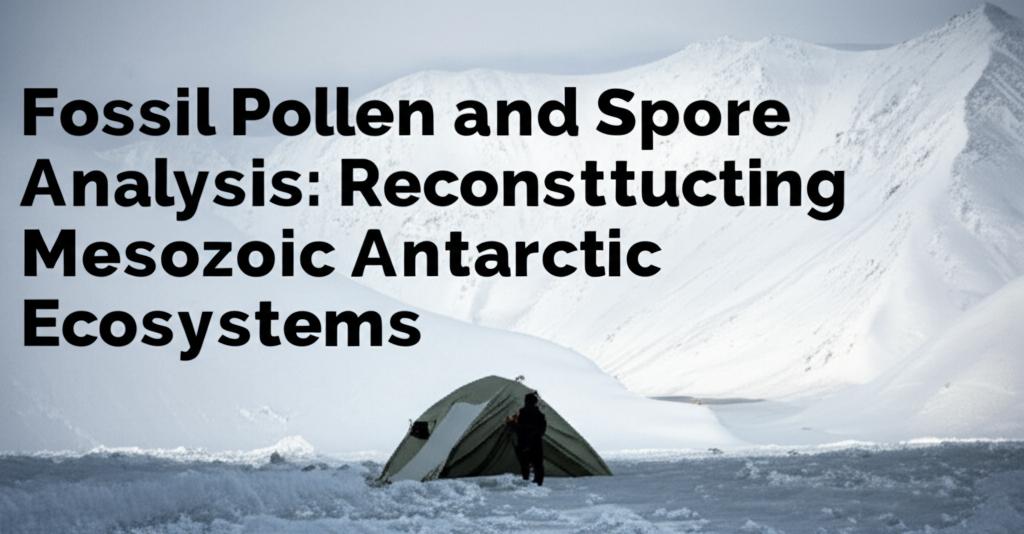The study of fossil pollen and spores, a field known as palynology, provides a crucial window into understanding the ancient ecosystems of Mesozoic Antarctica. These microscopic particles, preserved in sedimentary rocks, allow scientists to reconstruct past vegetation, infer climatic conditions, and understand how life adapted to dramatic environmental shifts on the icy continent.
A Once Greener World:During the Mesozoic Era (roughly 252 to 66 million years ago), Antarctica was not the frozen landscape it is today. It was positioned further north and experienced a much warmer climate. Fossil evidence, including pollen and spores, reveals a continent covered in diverse vegetation.
- Cretaceous Rainforests: Remarkably, around 90 million years ago during the mid-Cretaceous period, temperate rainforests thrived near the South Pole. Analysis of fossilized roots, wood, pollen, and spores from sediment cores taken from the seabed near West Antarctica's Pine Island Glacier paints a picture of a swampy landscape with forests similar to those currently found in New Zealand. These forests persisted even with months of polar darkness. The presence of these rainforests suggests average annual air temperatures of around 12-13 degrees Celsius, with summer averages around 19-20 degrees Celsius. This evidence points to a significantly warmer world than previously thought for that era, with higher atmospheric carbon dioxide concentrations.
- Flowering Plants Emerge: The mid-Late Cretaceous (around 85 million years ago) saw flowering plants (angiosperms) flourish in subtropical climates on the Antarctic Peninsula. Many of these were ancestors of plant groups now found in tropical regions. The first remnants of flowering plants at high Antarctic latitudes have been identified through pollen analysis from this period.
- Conifer and Fern Dominance: Throughout much of the Mesozoic, Antarctic forests were dominated by conifers, such as araucarians (like monkey puzzle trees), and podocarps. Ferns, including tree ferns, forked ferns, and other primitive groups, formed a significant part of the understory. Liverworts, hornworts, lycophytes, and mosses also contributed to the ground cover.
The rich fossil pollen and spore record tracks the evolution of Antarctica's climate from a Cretaceous "greenhouse" state towards the "icehouse" conditions of the Neogene.
- Peak Warmth and Cooling: Following the peak warmth of the mid-Late Cretaceous, a global cooling trend is evident in the latest Cretaceous. However, warm climates returned to high latitudes during the Paleocene and early Eocene.
- Gradual Change: Over time, as temperatures cooled, warmth-loving plants gradually gave way to flora more tolerant of cooler conditions, including freezing winters. Southern beeches (Nothofagus) and araucarian conifers became more dominant.
- Adaptation to Darkness: The high-latitude location meant that Mesozoic Antarctic flora had to adapt to several months of winter darkness, impacting growing seasons.
The study of fossil pollen and spores provides invaluable data:
- Floral Communities: By identifying the types of pollen and spores present, scientists can reconstruct the composition of ancient plant communities.
- Climate Characterization: The types of plants present (and their modern relatives' climatic tolerances) allow for the estimation of past temperatures and moisture levels. For instance, the discovery of specific pollen types helped establish that January average temperatures on land reached around 10 degrees Celsius during a remarkably warm period about 15.7 million years ago.
- Environmental Changes: Shifts in pollen and spore assemblages over time indicate changes in the environment, such as cooling trends or alterations in rainfall.
- Biogeography: Fossil pollen helps trace the origins and migration routes of plant groups, revealing connections between Antarctica and other Southern Hemisphere continents like Australia and South America, which were once part of the supercontinent Gondwana. For example, fossil pollen records support the theory that the ancestor of Nothofagus may have originated in Antarctica during the Late Cretaceous.
Continued analysis of fossil pollen and spores from Antarctic sediments, including those obtained from geological drilling programs, remains critical. This research refines our understanding of:
- The timing and pace of past climate change in polar regions.
- The sensitivity of polar ecosystems and ice sheets to warming.
- How life adapts to extreme environmental shifts.
- The complex interplay between vegetation, climate, and continental configuration.
By piecing together the evidence preserved in these microscopic fossils, scientists continue to unveil the dramatic history of Antarctica's Mesozoic ecosystems, offering vital perspectives on Earth's climate system and the resilience of life.

